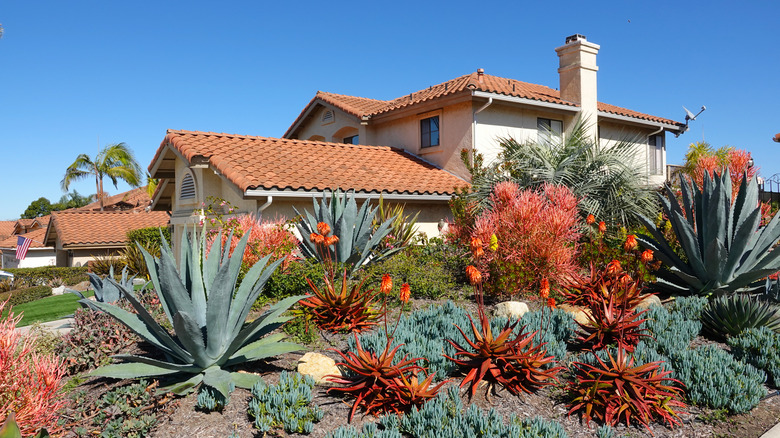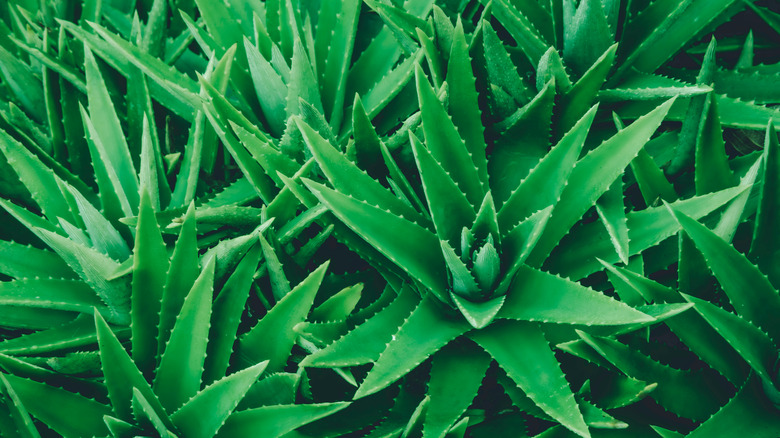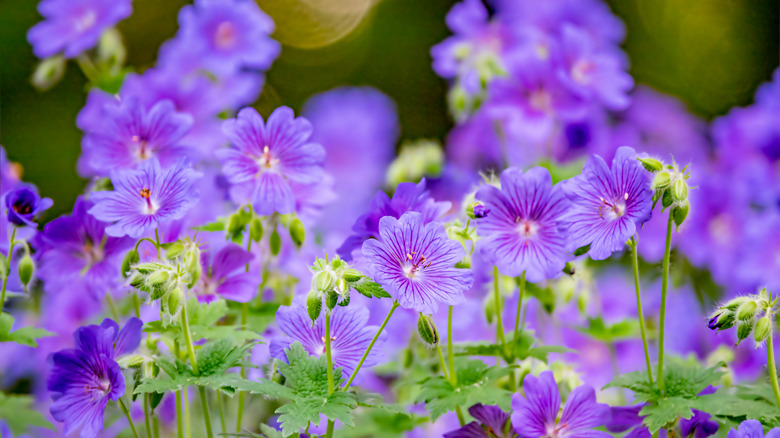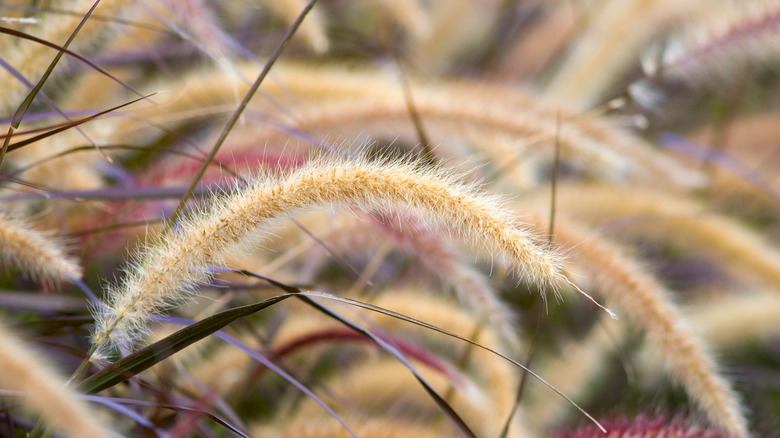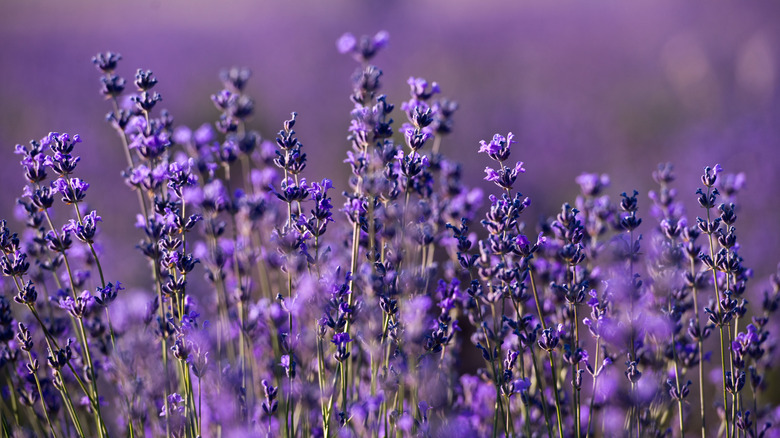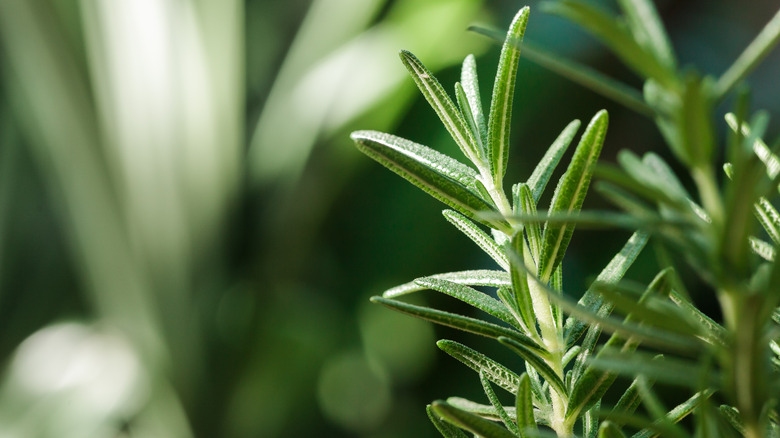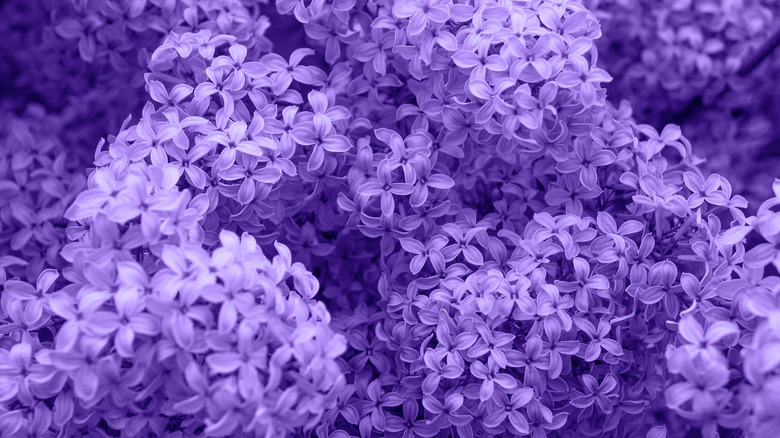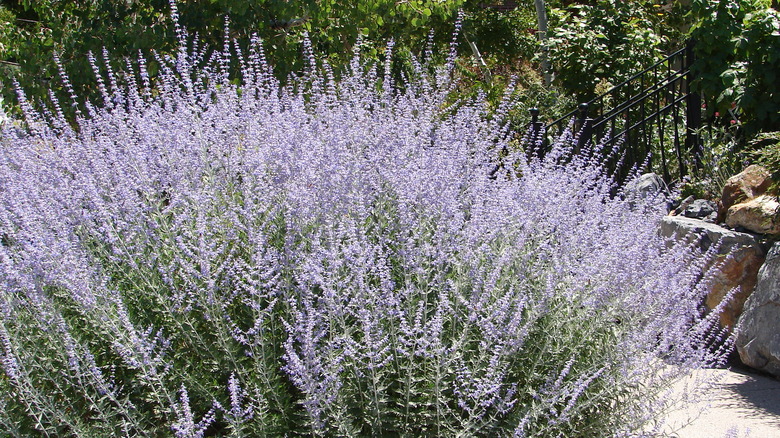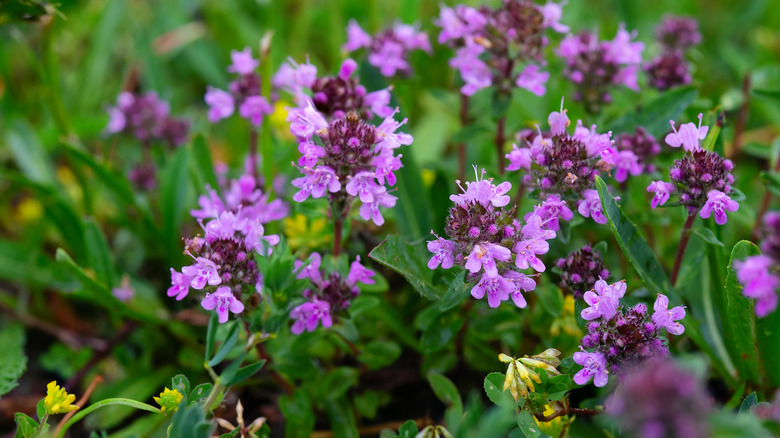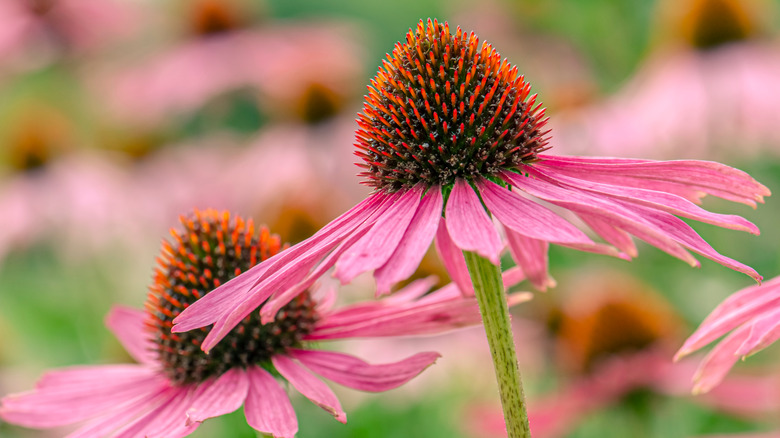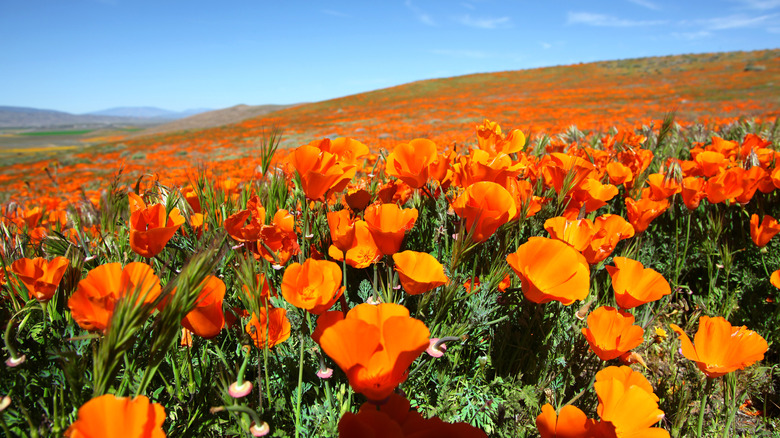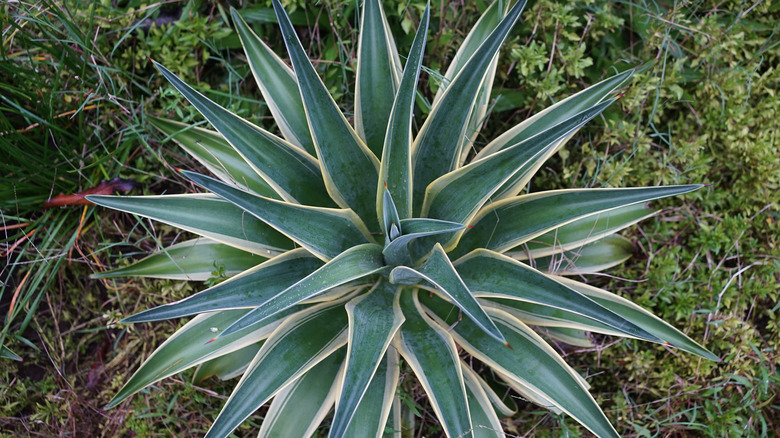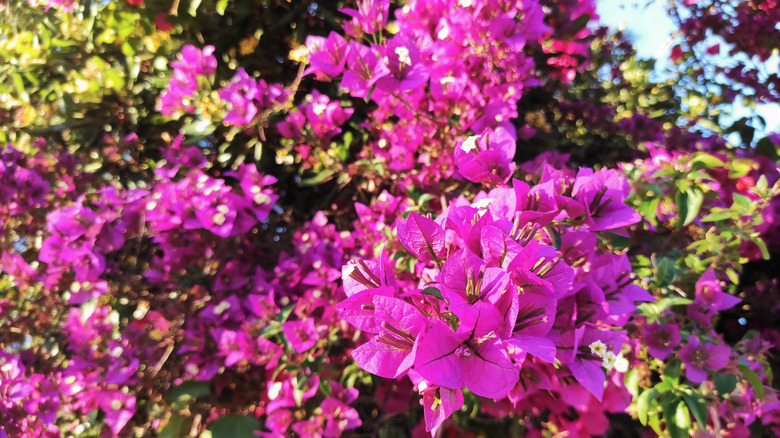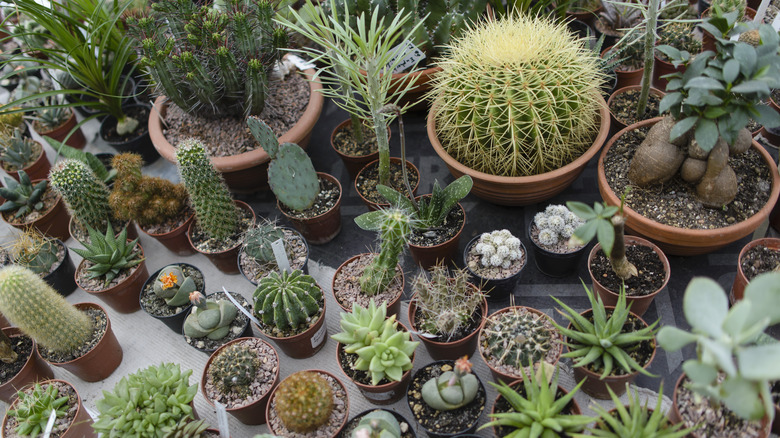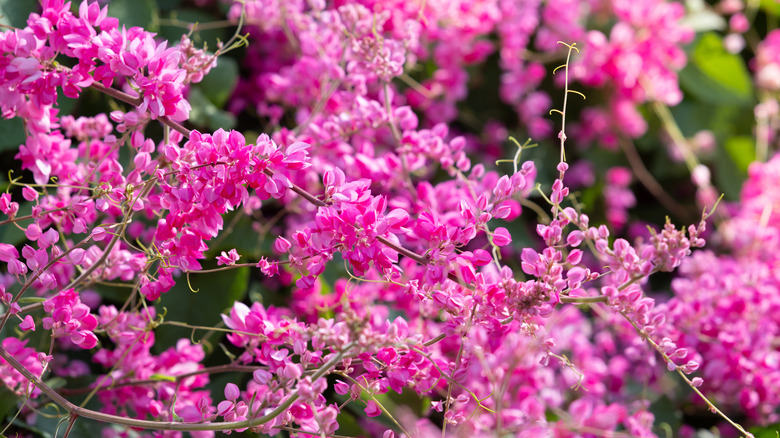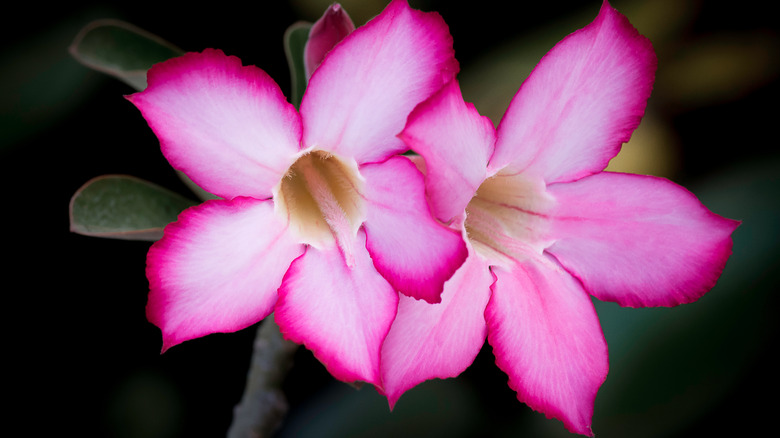15 Drought Resistant Plants That Will Thrive Without Much Water
Many parts of the United States experience drought-like conditions on a regular basis, according to the U.S. drought monitor, and many types of plants won't be able to survive when access to water is restricted. If you live in a dry climate, consider landscaping your property with drought resistant plants which are native to the area, rather than contributing to water shortages by trying to maintain a green lawn. The concept of xeriscaping involves creating your garden or landscape while using as little water as possible, according to National Geographic, and is an eco-friendly choice to reduce the need for frequent watering.
Whether you're interested in xeriscaping or simply want to ensure your garden will survive a drought, these are the plants you should consider. Read on to learn about some of the most drought resistant plants, vines, flowers, succulents, and herbs that will thrive even in the most arid conditions.
1. Aloe
Aloe vera (Aloe barbadensis) is commonly used in folk medicine and can grow indoors and outdoors in certain climates, according to Gardening Know How. Aloe is a type of succulent, and thrives in a dry climate, making it the perfect choice for those living in arid areas. With the right conditions, aloe is low-maintenance when grown outdoors, since it doesn't require frequent watering or any fertilizer. The Old Farmer's Almanac says that aloe does best when temperatures are between 55 and 80 degrees. It should be kept in an area that gets full sun. Extract the gel from the aloe vera leaves to make a DIY solution for soothing sunburns or using as a natural moisturizer.
USDA Growing Zone: 10 to 12
Sunlight needs: full sun
Soil Type: dry, well-draining
Size: one to two feet tall
2. Geranium
Geraniums (Pelargonium x hortorum) have been popular in North American for over 200 years due to their manageable care needs and ability to thrive in a number of different climates. They are Native to South Africa and do well in dry or even drought-like conditions. According to Gilmour, there are many different types of geraniums, each of which have their own maintenance requirements. While in some climates geraniums can exist as perennials, in most of the U.S. they should be wintered indoors, according to SF Gate.
USDA Growing Zone: 10 and 11
Sunlight needs: part sun, shade, and full sun
Soil Type: loose with organic matter
Size: one to two feet
3. Fountain Grass
Add some decorative grass to your landscaping project with fountain grass (Cenchrus setaceus). This ornamental grass attracts wildlife to the area, but fortunately is deer resistant, according to the Gardening Channel. At the end of the summer and early fall, fountain grass will produce showy blooms in shades of pink and silver. Grow fountain grass from seed or as a nursery transplant; once it's established, it can handle very low moisture conditions.
USDA Growing Zone: 6 to 9
Sunlight needs: part shade to full sun
Soil Type: well draining, medium moisture
Size: Up to three feet
4. English Lavender
Lavender (L. angustifolia) is both beautiful and practical, with its cuttings making both a lovely table centerpiece or an ingredient for baking, or even DIY projects. According to the University of California Cooperative's Master Gardener program, English lavender is used in aromatherapy and is found in products like soap, candles, and more. According to their report, the ancient Egyptians used lavender while mummifying their dead, monks used the plant in their health and hygiene, and Romans brought lavender to the bathhouse.
USDA Growing Zone: 5 to 8
Sunlight needs: full sun
Soil Type: well draining, gravelly
Size: two to three feet
5. Rosemary
Rosemary (Salvia rosmarinus) can be grown indoors or can act as an evergreen perennial in certain climates. Fine Gardening says that rosemary can serve as decorative plant in your garden, a flavor in your kitchen, and can even be a tool in aromatherapy. Rosemary does well when grown in a container, and should be brought indoors when temperatures fall below 30 degrees. Transplant rosemary into bigger pots twice a year to help it grow.
USDA Growing Zone: 7 to 10
Sunlight needs: full sun
Soil Type: well draining
Size: Up to five feet
6. California Lilac
California Lilac (Ceanothus) is a flowering shrub that's drought tolerant and fast growing in the right conditions. It only needs water once or twice a month in the summer, making it a perfect pick for growing in arid climates. California lilac is native to North America and typically flowers from mid-spring to the beginning of winter, providing beautiful blooms for months. According to Gardenia, lilac is also known to bring pollinators like bees, butterflies, birds, and more to your garden.
USDA Growing Zone: 8 to 10
Sunlight needs: full sun
Soil Type: well draining
Size: Up to nine feet
7. Russian Sage
Don't be confused by the name of Russian sage (Perovskia atriplicifolia); it's nothing like the herb you're used to cooking with. In fact, according to HGTV, Russian sage looks more like lavender than sage. It thrives in hot climates and needs a lot of sun, so be sure to plant it in an area that gets at least six hours of sunlight per day. Russian sage can't handle high humidity or damp soil, so it's the perfect ornamental plant for glowing in drought conditions. Plant each one three feet apart so they have plenty of room to spread.
USDA Growing Zone: 5 to 9
Sunlight needs: full sun
Soil Type: well draining
Size: three to five feet
8. Creeping Thyme
Creeping thyme (Thymus spp.) is native to Southern Europe and acts as a pretty ground cover option in warm, dry climates. It produces a pleasant smell and the leaves are edible and used for cooking in some cultures. Creeping thyme blooms with pink, purple, or white flowers depending on the variety, according to The Spruce. There's no need to fertilize creeping thyme, and one of the only problems it encounters is root rot if the soil is too damp.
USDA Growing Zone: 4 to 9
Sunlight needs: full sun
Soil Type: well draining, loose
Size: two to six inches
9. Coneflower
Coneflowers (Echinacea spp.) originated in North America and can survive in a wide range of climates. According to the The Old Farmer's Almanac, they grow in the eastern section of the U.S., north from Georgia and Louisiana to Ohio and Iowa. Their gorgeous flowers can bloom in a rainbow of colors, including green, orange, pink, purple, red, white, and yellow. Their scientific name is derived from the Latin word echinus, which means hedgehog due to their spiky stems. Because of their prickly stems, coneflowers are also deer resistant.
USDA Growing Zone: 3 to 9
Sunlight needs: full sun
Soil Type: loamy
Size: two to four feet
10. California Poppy
According to the U.S. Forest Service, the California poppy (Eschscholzia californica) is the state's official flower, and it is native to the west coast from Mexico up to Oregon. While they can survive as an annual in USDA hardiness zones 5 through 7, in zones 8 through 10 they are capable of acting as a perennial, according to SF Gate. Poppies are best appreciated in the wild or in your garden, because they quickly lose their petals when picked.
USDA Growing Zone: 5 to 10
Sunlight needs: full sun
Soil Type: sandy, well-drained
Size: two to four feet
11. Agave
Agave (Agave spp.) is a type of succulent that has either blue-green or gray-green foliage, depending on the type. These show-stopping plants are easy to care for and don't require much maintenance. According to The Spruce, agave really are easy to maintain as they don't need a ton of attention. As long as they have enough sunlight and are planted in soil that doesn't hold onto moisture, they will flourish. As well as thriving outdoors in drought-like conditions, agave can also grow in a container inside in cooler climates.
USDA Growing Zone: 5 to 11
Sunlight needs: full sun
Soil Type: sandy, well-drained
Size: up to 20 feet
12. Bougainvillea
Bougainvillea (Bougainvillea sp.) is a tropical spreading plant that needs plenty of sun. It can be trained to act as a vine to cover a wall or trellis (via Better Homes & Gardens). According to Garden Design, most bougainvillea have small blooms that are white in color, while the bracts around the flower can have a range of hues from magenta to orange to red and more. Choose a variety based on the color of your choice.
USDA Growing Zone: 9 to 11
Sunlight needs: full sun
Soil Type: well-drained
Size: up to 20 feet
13. Cacti
When it comes to drought-tolerant plants, the first ones to come to mind for many are cacti (Cactaceae). Since they're known for growing in the desert, it won't come as much of a surprise that they're perfectly capable of surviving in extremely dry conditions. According to My Garden Life, these hearty plants are among the most adaptable and varied you'll find out there. They're native to the Americas and depending on the variety, cacti can even be cold-tolerant. Because of their spiky spines, cacti are resistant to most animals, including deer.
USDA Growing Zone: varies
Sunlight needs: full sun
Soil Type: well-drained, sandy
Size: varies
14. Coral Vine (Mexican Creeper)
Coral vine (Antigonon leptopus) is also known as Mexican creeper or queen's wrath vine, as noted by Gardening Know How. It's native to Mexico, and is most likely to survive in warm climates. Due to its tendrils, coral vine does best when it's trained to grow on a wall, fence, or trellis. Do your research before planting coral vine in your garden, because it's actually considered an invasive species in certain parts of the country due to its ability to choke out other plants.
USDA Growing Zone: 9 to 11
Sunlight needs: full sun
Soil Type: well-drained
Size: 40 feet
15. Desert Rose
Desert rose (Adenium obesum) can only grow outdoors in the warmest parts of the country, but it can also survive indoors as a houseplant. While the desert rose is drought tolerant, its blooms will look their best if they're given access to water during the growing season in the spring and summer. It's important to note that the desert rose is toxic to both humans and animals, according to The Spruce, so it might not be the best choice for your garden if you have pets or small children.
USDA Growing Zone: 11 and 12
Sunlight needs: full sun
Soil Type: well-drained, sandy
Size: three to nine feet tall
